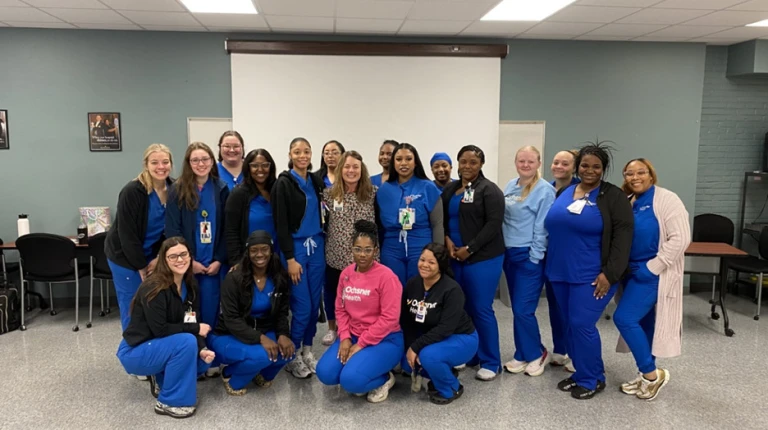When Tiffany Murdock, MBA, MSN, BSN, RN, reflects on what’s driving transformation across Ochsner Health, where she is the Senior Vice President and Chief Nursing Officer, she starts with mindset.
“You have to listen as fast as you’re willing to change,” she says. “Agility is the name of the game, as well as consistency and authenticity. That is the reason we’ve been able to move so quickly.”
In her role leading more than 10,000 nurses across the Gulf South region, Murdock’s approach shows that many of the most persistent challenges in nursing, like documentation overload, time-consuming discharges, and disconnection from purpose, aren’t intractable. If leaders listen, invest, and hold themselves accountable, they’re solvable.
Just two years into her role, Murdock and her team have made substantial progress in helping nurses reclaim time, energy, and joy in care. Here’s how:
“Listen and connect to the humans who are doing the work”
For Murdock, the foundation of leadership is listening. She and her team are on the ground with frontline nurses, not just collecting survey data, but observing, rounding, and adjusting.
“Tell me what value means to you. Define purpose, define what having a voice means,” she said. “From there, we created our strategy, and we haven’t looked back since.”
That commitment has produced measurable impact across Ochsner’s 46 hospitals and more than 370 health and urgent care centers:
- RN turnover decreased from 12.77% in 2023 to 9.40% in 2024, a reduction of 3.37 percentage points. This represents a 26.4% improvement in turnover year-over-year.
- Documentation optimization saved nurses 10 minutes per shift, adding up to hundreds of hours reclaimed for patient care
- Flowsheet macros in Epic eliminated over 11 million clicks, dramatically reducing digital burden in clinical workflows
Each of these wins began with listening and evolved into real-world change, Murdock says.
“We wanted to be the best place a nurse could work”
One of the most powerful examples of this agile, human-centered leadership is Ochsner’s virtual nursing program. What started as an effort to rethink discharge became a breakthrough for both patients and nurses. The integrated care model is built on the partnership between bedside and virtual nurses, who share responsibility for a group of patients.
Covering 615 beds across 14 hospitals and 19 units, the program has now supported over 22,500 discharges, or more than 90% of patients discharged to home, and the results are clear:
- Approximately 7,500 hours saved for bedside staff
- 2% reduction in readmissions on participating units
- Improved patient satisfaction scores related to discharge and medication education
- Higher nurse satisfaction, with less time on administrative tasks and more time at the bedside
“We’ve seen readmissions reduced, better medication reconciliation, better patient experience,” Murdock said. “There are clear quality metrics, on top of making people’s lives easier.”
“You have to be able to fail and fail fast”
Murdock’s approach is refreshingly straightforward: Remove what’s unnecessary. Automate what can be automated. Invest in what gives nurses their time, focus, and purpose back.
That said, not every initiative will necessarily succeed. And that’s why it’s essential to conduct pilots and “fail and fail fast – and then move on.”
She shares an example: “We thought remote monitoring on the inpatient side was going to be a hands-down easy win. But there’s so much more to it than that, because our patients are so complex,” she said. “We learned how to be even more intentional with how we roll out digital tools.”
“We can’t train nurses like we did in the past”
Ochsner nursing supports 4,000 nursing learners per year, and more than 1,000 clinical rotation students have been hired upon graduation in the last three years. Leveraging the Vizient/AACN Nurse Residency Program™, Ochsner works to empower new nurses through skill development and mentorship.
“It’s an awesome resource,” said Maria Nix, MSN, BSN, RN, a nurse clinical educator at Ochsner. “It helps nurses develop critical thinking skills, facilitates networking, and teaches reflective practice, which is so essential. It’s an opportunity for experienced nurses to share their wisdom and help new nurses navigate the nursing profession.”
Facing preceptor shortages, Murdock and the organization’s System Nursing Professional Development team are also evaluating ways to leverage virtual preceptors to enhance support for new nurses.
“We cannot do education in the same way we’ve always done it, with one preceptor to one nurse in 12 weeks,” Murdock said. “You have to be prepared to think differently.”
“There’s no silver bullet”
With efforts focused on people and culture, financial accountability and sustainable growth as well as digital leadership, there is no silver bullet solution. Success is all about trust – and trust is built on honesty.
“The best advice I can offer is to be honest with people and work as hard as they are,” she says. “If your team trusts you’re doing things for the right reasons, they can reconnect to their purpose, and the results are pretty immediate.”
Nurses – looking for opportunities to strengthen your innovation and leadership skills? Click here to learn about upcoming opportunities.




